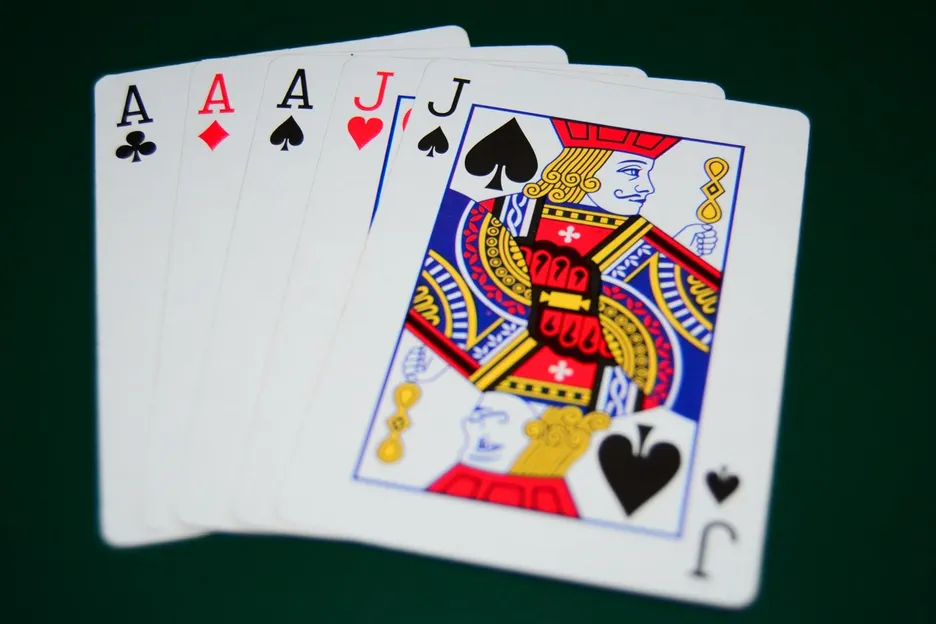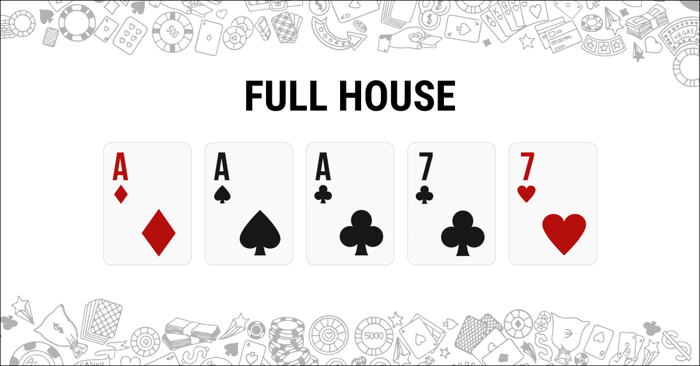What is a Full House?
A Full House is a poker hand that contains three cards of one rank and two cards of another rank. For example, three Kings and two Aces (K-K-K-A-A) or three 7s and two Jacks (7-7-7-J-J). It ranks below a Straight Flush but above a Flush in the standard poker hand rankings.
This powerful hand is often referred to by combining the ranks of the cards, with the three-of-a-kind mentioned first. For instance, "Kings full of Aces" (K-K-K-A-A) or "Sevens full of Jacks" (7-7-7-J-J).

A Kings full of Aces – a strong Full House that will win most hands
When comparing Full Houses, the rank of the three cards takes precedence. For example, K-K-K-2-2 (Kings full of Deuces) beats Q-Q-Q-A-A (Queens full of Aces), even though Aces are higher than Deuces. If the three-card ranks are the same, then the pair's rank determines the winner.
Full House Odds and Probability
A Full House is much more common than higher-ranking hands like Straight Flushes and Four of a Kind. Here's how it stacks up against other poker hands:
| Poker Hand | Combinations | Probability | Odds Against |
|---|---|---|---|
| Royal Flush | 4 | 0.000154% | 649,739 : 1 |
| Straight Flush | 36 | 0.00139% | 72,192 : 1 |
| Four of a Kind | 624 | 0.0240% | 4,164 : 1 |
| Full House | 3,744 | 0.1441% | 693 : 1 |
In Texas Hold'em, the odds improve considerably because you're using 7 cards (your 2 hole cards plus 5 community cards) to make the best 5-card hand:
- The probability of making a Full House by the river is approximately 2.60%
- This translates to odds of about 37:1 against making a Full House in any given hand
Why Full Houses Are More Common
There are 13 ranks in a deck (2 through Ace) and 4 cards of each rank. This creates numerous possibilities for forming three-of-a-kind and pairs combinations.
The total number of possible Full House combinations is 3,744 because:
- You can choose any of the 13 ranks for your three-of-a-kind
- Then any of the remaining 12 ranks for your pair
- There are 4 ways to choose 3 cards of the same rank (C(4,3) = 4)
- There are 6 ways to choose 2 cards of the same rank (C(4,2) = 6)
- Total: 13 × 12 × 4 × 6 = 3,744 combinations

Full Houses are ranked first by the three-of-a-kind component, then by the pair
Strategy: Playing a Full House
A Full House is a very strong hand, but unlike Royal Flushes or Straight Flushes, there are several hands that can beat it. This makes the strategic play of a Full House more nuanced:
Tips for Playing a Full House
Full House Betting Strategy
- Assess board texture: Look at the community cards to evaluate how strong your Full House is relative to possible stronger Full Houses.
- Value bet aggressively: With a strong Full House (high three-of-a-kind), you should typically bet for value to build the pot.
- Consider slow playing: With a very strong Full House on a draw-heavy board, you might slow play to let opponents catch second-best hands.
- Watch for paired boards: If the board has a pair, be aware that others might have Full Houses too. The player with the higher Full House will win.
- Be cautious with low Full Houses: If you have a low Full House (like 2s full of 3s) on a board where higher Full Houses are possible, proceed with caution.
Common Full House Scenarios
Understanding typical Full House scenarios will help you play them more effectively:
Flopped Full House: If you flop a Full House (e.g., holding A-A and the flop comes A-K-K), you have a very strong hand. However, your betting strategy should account for the board texture and possible draws.
Turned or Rivered Full House: If you make a Full House on the turn or river, consider how the board has developed and whether opponents might have stronger hands or were drawing to better hands.
Pocket Pair Making Full House: Starting with a pocket pair (like 8-8) and hitting a Full House when the board pairs (like K-K-2) gives you a disguised hand that opponents might not see coming.
Full House Fun Fact
The term "Full House" or "Full Boat" in poker is believed to date back to the riverboat gambling days of the 19th century, where a boat "full" of matching cards was considered a powerful hand.
Drawing to a Full House
While you shouldn't specifically chase a Full House from the start of a hand, there are many situations where you might find yourself drawing to one.
Common Full House Draws
Here are some typical scenarios where you might be drawing to a Full House:
- Three-of-a-Kind Looking for a Pair: If you have three-of-a-kind (trips), you're just one pair away from a Full House.
- Pocket Pair with Another Pair on Board: If you have a pocket pair and there's another pair on the board, you're one card away from a Full House.
- Two Pair Looking for a Third Card: If you have two pair, you can make a Full House if one of your pairs becomes three-of-a-kind.
Calculating Your Odds
When drawing to a Full House, it's essential to understand your odds of completing the hand:
- From Three-of-a-Kind to Full House: With three-of-a-kind on the flop, you have about a 33.4% chance of making a Full House by the river.
- From Two Pair to Full House: With two pair on the flop, you have approximately a 16.7% chance of improving to a Full House by the river.
- From Pocket Pair to Full House (when board has a pair): If the flop has a pair and you hold a different pocket pair, you have about a 15.5% chance of making a Full House by the river.
Always compare these odds to the pot odds being offered before deciding whether to continue drawing.
Full House in Different Poker Variants
The Full House maintains its ranking across most poker variants, but how frequently it appears and how it's played can vary:
Texas Hold'em
In Texas Hold'em, Full Houses are relatively common because you're using 7 cards to make your best 5-card hand. They often occur when the board is paired, and a player holds a card that matches one of the paired board cards.
Omaha
Full Houses are even more common in Omaha since players receive four hole cards. However, remember that you must use exactly two of your hole cards and three community cards in Omaha, which creates some unique constraints.
Seven-Card Stud
In Seven-Card Stud, Full Houses are important hands that often win at showdown. Since all players can see some of each other's cards, you can make better informed decisions about the likelihood that opponents have stronger hands.
Short-Deck Poker
In Short-Deck (also known as Six Plus Hold'em), where cards below 6 are removed from the deck, the hand rankings are modified. A Full House ranks above a Flush (opposite to standard rankings) because Flushes become more common than Full Houses in this variant.
Common Mistakes When Playing Full Houses
Even experienced players can make mistakes when playing Full Houses. Here are some common errors to avoid:
- Overvaluing weak Full Houses: Not all Full Houses are created equal. A low Full House like 2s full of 3s is much weaker than Aces full of Kings.
- Not considering board texture: If the board is paired with high cards, be aware that opponents might have stronger Full Houses.
- Playing too passively: A Full House is strong enough to bet and raise with in most situations. Playing too passively can cost you value.
- Not adjusting to table dynamics: Against tight players, you might want to extract value slowly. Against loose players, you can often get paid off more easily.
- Failing to recognize when beaten: If there's significant action on a board where a stronger Full House is possible, be prepared to fold your weaker Full House.
Quick Tips for Beginners
- Full Houses are very strong hands, but they're not invincible.
- Pay attention to the board texture and what it means for possible stronger hands.
- Think about your Full House in terms of its relative strength compared to other possible Full Houses.
- Practice calculating your odds of making a Full House from different starting points.
- When you have a Full House, focus on getting maximum value rather than trying to be tricky.